[ page 2 ]
1/72 scale kits of the MiG-23 and MiG-27 family (NATO "Flogger")
... continued from page 1...
Yes, I known the recent MiG-23 series
of RV AIRCRAFT are currently the best kits in 1/72 scale. But having a
whole pile of old MiG-23 kits, I decided to make these older models nevertheless
with often new decals and attractive camouflage schemes.
Page 2
Page 3
Page 4
Page 5
Page 6
Page 5..
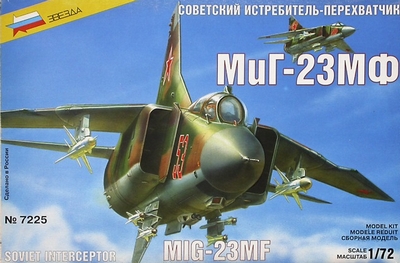
Zvezda MiG-23 (kit #7225)
Zvezda has a whole series of MiG-23 kits. They share the same basic parts but with some changes for particular versions.
Kit #7225 is quoted to be for a MiG-23MF and the kit dates from 1996. It has about 75 parts. The kit has the "notched" wing glove leading edge as in the kit but this is only applicable for a MiG-23 MLD. The overall dimensions are a bit inaccurate: the overall length is about 7 mm too short (mostly in the nose area). Also the exhaust pipe a bit small and the wing gloves too thick. (my modelling friend Rob de Bie has done accuracy analysis... look here at Rob's page...)
The cockpit interior in the kit is terrible with a very large seat and crude detail. It was decided to close the canopy although the canopy and windshield are far too big and too high. The schemes suggested in the kit are also vague and can not be checked.
The model was assembled as indicated in the instructions for the main parts. But most crude raised panel lines were sanded off. I did not bother with the other inaccuracies as it would be a lot of work to correct. But the horizontal stabilizers #9, 10 were set 1 mm higher, now just below the aft speed brakes. This looks better.
The wing halves were aligned a bit
better to keep a symmetric pose with some card inside:



The panel lines are raised and most
were sanded off during assembly. And quite some putty and sanding was needed.
 ..
..
After the sanding effort, the model
got a base grey coat to check for any errors. Usually I use an airbrush
with a simple paint like Revell Aqua 75 "Steingrau".

Still some filling with putty and
sanding was needed.... Note also the "notched" wing glove for the MLD.
 .
.

Below the nose, an IR tracker fairing was installed as in the kit.
Focus is now on the paint scheme of
a rare Ivory Coast air force MiG-23MLD. The kit has the notched
wing glove leading edge so is in that respect correct. Also, the vertical
tail has no upper dorsal fin. (The MLD was the final version of the MiG-23,
see
page 1).
The book "Soviet and Russian Military
aircraft" in Africa (see references) shows a drawing on page 100 and a
very rare photo of the MLA but the text suggests also a few MLD 's through
Bulgaria were delivered in 2004.
Camouflage colours interpreted as:
Dark green: AKAN 73024
Medium green: Revell Aqua 360
Brown: AKAN 73080 acrylic
Light blue lower surfaces:
AKAN 73008 acrylic
These were airbrushed with the Harder Steenbeck double action airbrush.
The model was ready for the decals, but first a couple of gloss coats were added using with my usual technique.
Only a few decals were added. The
rare photo of a MLA of the book noted above shows no clear roundel as the
nose area of the aircraft is covered. But it is very probable that a roundel
is on the nose, so this was set in place: the Ivory Coast roundel was made
by using an IRAN roundel from the spares box and combining it with an orange
dot in the middle from a Dutch decal roundel.
When decalling was done, a trick
made the decals look better on the model: with the airbrush, very thin
coats of the previosuly applied paints were "oversprayed" in some areas,
this "blends" the decals into the surface. It looks pretty good.
The final coat was a final semi-matt coat. This was achieved with the usual technique by airbrushing a gloss coat of Johnson Future acrylic with 5% mixed in Tamiya X-21 "flat base" acrylic paint.
The landing gear assembly is a bit awkward to ensure a correct alignment. The main wheels have "holes" to fit the main gear legs, but I found these pegs to pose an inaccurate look so one was removed on each side.
The canopy was closed, inside I also installed a simple spare set after it got a few harness details made from tape. gaps were closed with white glue and painted.
Almost done, the model also got two
R60 missiles (retrieved from an ICM 1/72 missile set) below the fuselage.
The pylons came from the kit #47. That completed this model.
![]()
IVORY COAST
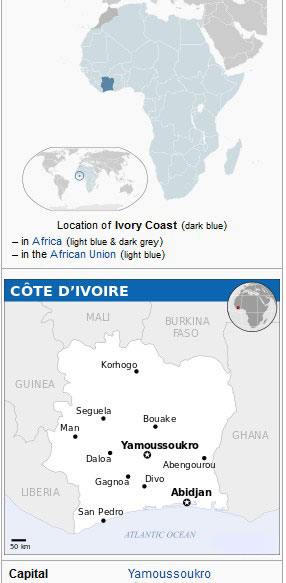 .
. . .
. . ..
..
[ area: 322,500 sq.km | capital: Yamoussoukro | population 24 million | GDP US $ 1,900 per capita nominal ]
This
former
French colony "Cote d' Ivoire" (in English "the Ivory Coast") became
independent
in August 1960. With French assistance armed forces were set-up. The army
started with Max Holste Broussard aircraft and a DC-3 and later the air
force was established and some C-47's were obtained as well. It's air
force had a very limited operational capability for decades.
A few Alouette II and III helicopters were used in the 1970s with some
Cessna's and also a pair of Fokker F-27 transports from 1970 to 1979.
The president also had a Fokker F28 from 1975 until 1993.
The first jet aircraft type was the Alpha Jet C1, arriving in 1980 with 6 delivered (and later 1 extra) and the
fighter flight was based at Bouake. A Fokker 100 replaced in 1994 the
F28 as VIP transport. In 2001 there was another coupe d'etat and
rebels remained active also in the region of Bouake. The new leftist
president turned to the Soviet block countries and acquired 2
Sukhoi Su-25 from Belarus and these were delivered and flown by Belarus
pilots despite the French arms embargo. Also through Bulgaria
in 2002 a pair of refurbished ex-Bulgarian MiG-23MLD aircraft were bought. Meanwhile from 2002 some Mi-24 Hinds were also acquired. The pair MiG-23 still located in Togo were exchanged for a pair of SU-25UB that were transferred to Cote d' Ivoire in 2004.
An deadly attack was done at a French detachment at Bouake on 6 November 2004 and the French decided to destroy the small Cote d' Ivoire force aerienne with attacks on Abidjan base. The pair of MiG-23 MLD fled quickly to avoid destruction to Lomé in Togo. These aircraft were probably never actually operated from Abidjan.
In 2010 there was a regime change in Cote d'Ivoire after elections. Helicopters, often with civilian registration, were acquired like SA365 Dauphins. The current "Force Aérienne de la Côte d'Ivoire" has no active jet fighters but a few VIP aircraft, a Antonov AN-26, CASA CN925, Beech 350 transport and a few armed Mil Mi-24 Hinds helicopters, all based at the only base aerienne at Abidjan / Port Bouet international airport. Across the country are a few dozen civilian airfields.

The biggest inaccuracy of the basic
kit made is clearly seen here in the canopy area, it looks "too big". But nevertheless
a nice MiG-23MLD model in the collection of a rare air force. The MLD has
the notched wing glove leading edge clearly seen in the view below...

 MiG-23 MLD coded "CH", c/n 27204/18421 (BGR "204 white" ) and first seen april 2003. It was still seen there derelict in 2016 along with companion sister "25 white".
MiG-23 MLD coded "CH", c/n 27204/18421 (BGR "204 white" ) and first seen april 2003. It was still seen there derelict in 2016 along with companion sister "25 white".

Abidjan / Port Bouet main airport:
 courtesy Google Earth imaging
courtesy Google Earth imaging
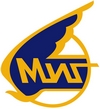
MiG OKB.

RV Aircraft MiG-23B
This kit #72019 of the year 2013 is a very nice kit of the series of MiG-23 kits of "RV Aircraft".
The number of parts (mostly in light brown plastic) in this kit is about 100 and includes a photo etched fret for the details. For this BM version the "duck nose" is obviously in the kit (as grey parts) and also has the side armour plates, but the normal MF nose is still found in the sprues. The same is true for the vertical tail: one with or without dorsal fin is provided.
The kit instructions are a bit vague in some areas to clearly indicate what parts are needed for a particular version. Also, detailed colour instructions are not provided for the details. All panels lines are finely recessed and very impressive. But there are NO locating pins for the parts so alignment needs more care to avoid ridges. And the kit has NO external weapon stores are provided so any desired must be sourced elsewhere.
This kit release also has a few resin parts for the aft bomb racks, very nice. Also a resin exhaust nozzle is provided and additional two resin horizontal tailplanes. So you have a lot of welcome "left overs" that can be used for improving older simpler kits.
Decals in this kit are for the MiG-23BM first Soviet prototype "blue 351" in a camouflage scheme. (may be I mixed up some decal sheets, but I think no other scheme was in the kit).
I compared the RV Aircraft vertical
tail with an old Zvezda/Italeri Mig-27 kit and they agree on the
basic shapes:
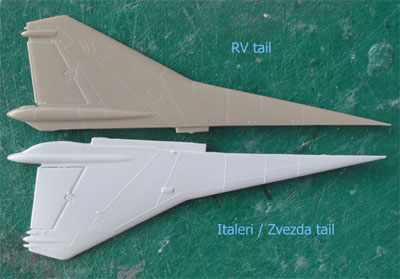
It was decided to a small conversion into a MiG-23BN as used by Ethiopia. (I found out too late that RV also has this version in a kit #72018 with a different exhaust nozzle).
Basic construction started with cockpit
tub (which is very nicely detailed), nose and aft sections. This MiG version
has the large style "boundary layer" splitter plates with parts #21, 23.
 ..
..
The main fuselage wing gloves with
the swivelling wing is not a very tight fit. Before closing up the fuselage
upper and lower parts, I added a 2 mm extra rod bit on top of the rotating
pins. Still, the wing "wobbles". But the wing can be clicked in at a later
stage.
 ..
..
The fuselage was further assembled.
The separate air brakes are nice but when set closed do not fit, so sanding
was needed on their insides. Remaining gaps were closed with white glue.
The wing glove leading edge parts #39, 40 need some putty. (The missile
emitter fairing #43 below the wing glove is a separate part; it was fitted
to most BN aircraft but I believe not on the Ethiopian aircraft).
The model was given now a base grey
coat to check for any error in filling and sanding.


For the exhaust pipe for this version
is provided as a separate resin part is provided but I did no bother to
fit the internal pipe structure with parts #27, 30.
NOTE: Later, I discovered that I made an error retaining the "long" afterburner as I wanted to make a "BN" that had a slightly derated R-29B engine with short jet pipe. Discovered very late, I got the razor saw and cut it off. Unable to install a fine detailed shorter nozzle, I simply wil put of a "exhaust pipe" protection plate/cover that was painted red.
The cockpit of the kit looks nice with details and cockpit interior colour was painted with AKAN 73005 "emerald green". The lower folding tail fin has parts #31, 32, 33. I did not yet fit the lower folding fin #32 and the undercarriage assembly will be done after airbrushing the overall paint scheme.
The picked scheme is of an Ethiopia air force MiG-23BN aircraft using the Berna decal set 72-87. I found some drawings on the internet but also some profile drawings are found in the nice book "Soviet and Russian Military aircraft" in Africa (see references) ; on page 118 as well as some colour photos.
The following colours were used:
Light green: Gunze Sangyo 312 acrylic
;
Sand: Revell Aqua 314 ;
Light brown: AKAN 73080 ;
Green: Gunze Sangyo 303 ;
Dark brown: AKAN 73026
;
Lower blue surfaces: AKAN 7003 russian
blue ;
NOTE: I later found a rare photo and saw that the light green is much brighter so if you make this model better use a green like Revell 364 aqua.
Also, some darker green patches were airbrushed at some dots using AKAN 73024. Masking was done both with tape but also "loosely" by holding a carton at the eddes whiel airbrushing.
The model was ready for the decals,
but first a couple of gloss coats were added with the usual
technique. Decals were applied when the coat was dry.


The wing halves that also got their
decals were "snapped" in. It needs to be glued fixed to ensure a correct position
with dihedral. I also had to insert thin plastic bits to get the correct and symmetrical dihedral angles.
The model was now almost ready for final assembly. A similar "overspray trick" and semi-matt coat was applied as described above....
OK, now the assembly of the undercarriage was now done. The multi-part undercarriage legs of this RV Aircraft kit are a bit awkward but unused and thus spare parts are also here for different gear legs and wheels. It seems the main wheels sit "too low" so I had to do a bit re-aligning. Two types of nose wheels are also provided with parts #59 probably needed. (this is not well indicated in the kit instructions). Very nice is an optional mud guard #61 or #62. But the Ethiopian aircraft have no mud guard.
Final assembly also means installing all the pitots, tubes and probes and all are provided in the kit including resin ones. I also added a few FAB 500 bombs from an ICM "Soviet" weapons set on the rear fuselage pylons. This is a special feature of the later MiG-27.
Next, an end semi-gloss coat was applied with the usual technique.
The cockpit canopy inside frames were painted AKAN 73005 "emerald green". A mirror was made from scrap and installed in the edge. The seat form the kit set in place after it got some straps made from tape. After that canopy was installed hinged upwards and that completed this very nice model.
 ......
...... ......
......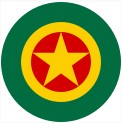
[Ethiopia
area: 1,100,000 sq.km excl. Eritrea | capital: Addis Abeba |
population: 112 million | GDP US 1,000 per capita nominal ]
In the 1950s Emperor Haile Selassie convinced the United Nations to establish the country of Ethiopia with Eritrea as a province and he ruled until 1974. In 1951 some Fairey Fireflies were acquired. In the 1950s with US assistance T-28 and T-33 followed and also F-86F Sabres fighters and in 1965 F-5A aircraft arrived.
The Ethiopian Emperor Haile Selassie was overtrown September 1974 by a Marxist officers. The Ethiopian air force was now the "Ityopya Ayer Hayl" and turned after some years of large unrest in 1977 to the Soviet Union and got the MiG-21 fighter in the seventies. Ethiopian etnical groups wanted independence and many conflicts erupted with Somalia and Eritrea in the North.
Aircraft types in the new marxist Ethiopean Air Force were first between 20 up to 40 MiG-17F fighter-bomber jets obtained in 1977 with a few MiG-15UTI trainers. Over 40 MiG-21MF fighters followed from 1978 with a few UM trainers with dozens of extra MiG-21 delivered the following years (probably over 100). These included also some 8 MiG-21R reconnaissance jets and from 1986 advanced MiG-21bis with also Cuban support. From 1977 also over 40 MiG-23BN "Flogger" fighter-bombers were delivered with a few MiG-23UB trainers. Additional MiG-23 were acquired inluding over 18 MiG-23ML and it is probable that nearly 100 MiG-23 were received. The main Ethiopean air base is Debre Zeit near Bishoftu and another important bases are at Dire Dawa and Bahir Dar with also MiG-23 aircraft based there.
(more info about Ethiopia on the MiG-21 page here...)

This MiG-23BN
coded "1288" flew with no. 12 squadron but it was flown to Djibouti in 1991 as the pilot defected.


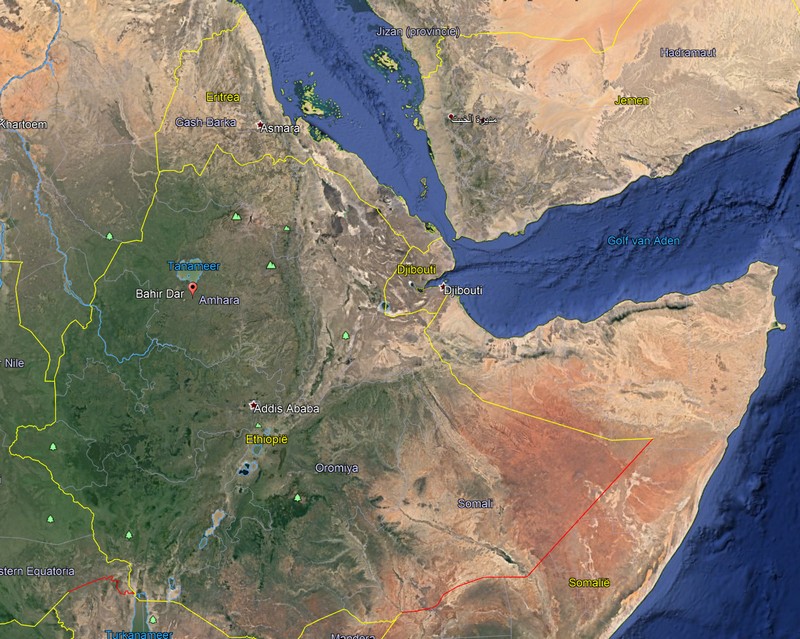
Bahir Dar air base:

detail:
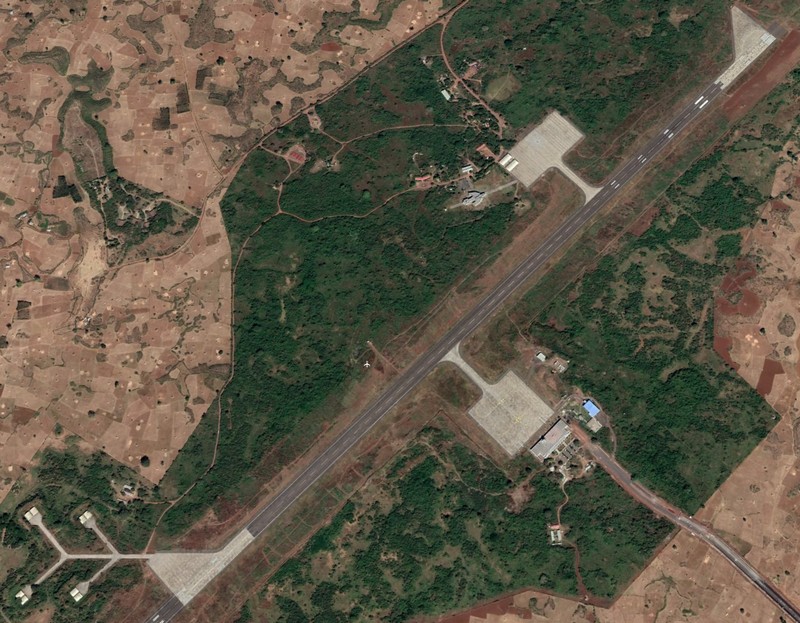
and shelter with visible MiG-23 tails :
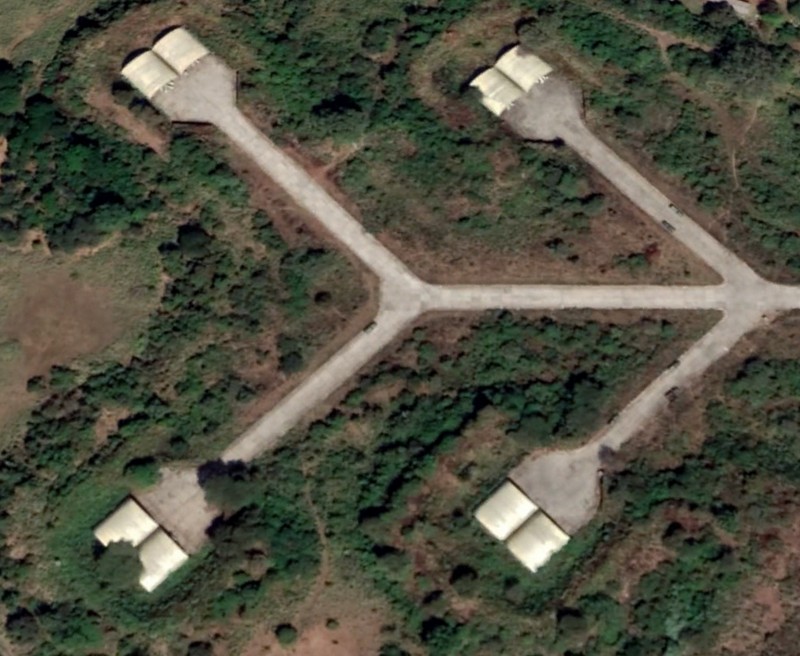
courtesy Google Earth imaging

Academy MiG-27D
Kit #12455 is for a "Flogger -D" and its release date was probably 1993. The kit is very basic and the cockpit has a seat "hump" with a floor but no side consoles and no control stick. Decals are for a single "Soviet aircraft" with red stars.
The nose shape seems very inaccurate and the nose length at the canopy location looks "too short". As I had a couple of spares nose halves and a radar nose from the RV Aircraft kit #72019, it was decided to do a complete conversion of quite a different type: the MiG-23MF in an Angola scheme using spare nose parts from an RV Aircraft kit. (The Academy canopy and windshield could still be used). Although not 100% sure, the MiG-23MF was also used as well as MiG-23ML and a few MiG-23UB trainers.
The strange stubs of the wing glove leading edge (on part #B15) were cut away. The simple wing halves were merged in the wing glove and the fuselage closed.
To get rid of the inaccurate nose, a spare "RV Aircraft" thick nose was "crafted" to the rear Academy fuselage. So the MiG-23 version changed to a thick nose one as seen on a MiG-23MF.
The assembly took putty and sanding.
From another Academy kit (seen below) intakes
were used... later I turned out I needed these....

Some card on top of the intakes and
putty was needed to get a flush fit.


The lower areas also needed putty
and sanding when dried.

As the MiG-23MF has a splitter plate,
one was used found as spare part.

In the cockpit some rod was installed
for the side consoles. The gap in the cockpit was closed with a rear bulkhead
from card. I added a control stick in the cockpit and the interior was
painted Russian green/blue with AKAN 73005 "emerald green".
The stores as indicated in STEP 10 of the instructions were not used, these are very very basic in the kit.
A model of the Angola air force MiG-23MF was made with roundels from the Berna set 72-87. Although the model is not perfect, it is much better than the original kit.
The book "Soviet and Russian Military
aircraft" in Africa (see references) shows a drawing on page 50. The colours
were interpreted as:
Lower blue: AKAN 7003 acrylic
"russian blue" (this being applied first, also not forgetting the gear
doors and pylons);
Dark green: Revell Aqua 65 acrylic
;
Light green: Gunze Sangyo 303
;
Brown: Revell Aqua 85 .


The model was ready for the decals,
but first a couple of gloss coats were added with my
usual technique. The Berna decals from set 72-87 went on fine.


The final finishing was installing
the landing gear, pitots and probes. And the Academy kit windshield was
fitted, needing some white glue to close gaps. When dry, this was painted
in the surrounding camouflage colours.

The nose gear bay looked too long as compared to the nose gear doors, so I inserted a piece of card of approx 3 mm width.

Some additional pylons were
installed and the lower gun pack. Also, UB-32 rocket pods were fitted obtained
from an ICM "Soviet" weapons set.

The lower fin was set folded as required
for a ground parked aircraft.

The model got the usual
semi-gloss end finish and canopy installed.
ANGOLA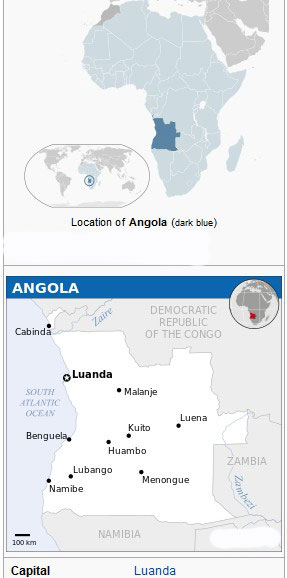 ..
.. ..
..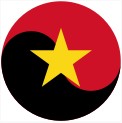 ..
..
[area: 1,246,700 sq.km | population: 33 million | capital: Luanda | GDP 3,700 USD per capita nominal ]
End 1975 the former Portuguese colony Angola claimed independence, the Portuguese left the country and a leftist government was installed. The Angolan Peoples Air Force "Forca Aerea Popular de Angola" (FAPA) was established and the Communist Block supported it with many aircraft being delivered. Starting the built-up as usual with MiG-17's and MiG-15UTI trainers, more advanced aircraft were to be used like the MiG-21. Also, several versions of the MiG-23 were delivered beginning with about 20 MiG-23MF and MiG-23ML aircraft. Current trainer aircraft are PC-7, Zlin 142, K-8 Karakorum and L-39. Transports are several Antonovs and VIP EMB120, ERJ135 and Yak-40. Fighters are Su-27 and Su-30 Flankers and a few remaining MiG-23. Various helicopters are used like Mi-8, Mi-25 and Mi-35 along with a few Bells and Gazelles.
There are a number of air bases in the country like Catumbela base no.5 , Lobito base no.4, Luanda "4 de Fevereiro" base no.1 and Lubango Mukanka base no.2 in the South (where many MiGs were based).

MiG-23MF coded red "C455" of the FAPA with the older roundel.



.


 .
.
.... and Kuito airport
Angola / Lubango Mukanka base no.2 in the South (where many MiGs were based):
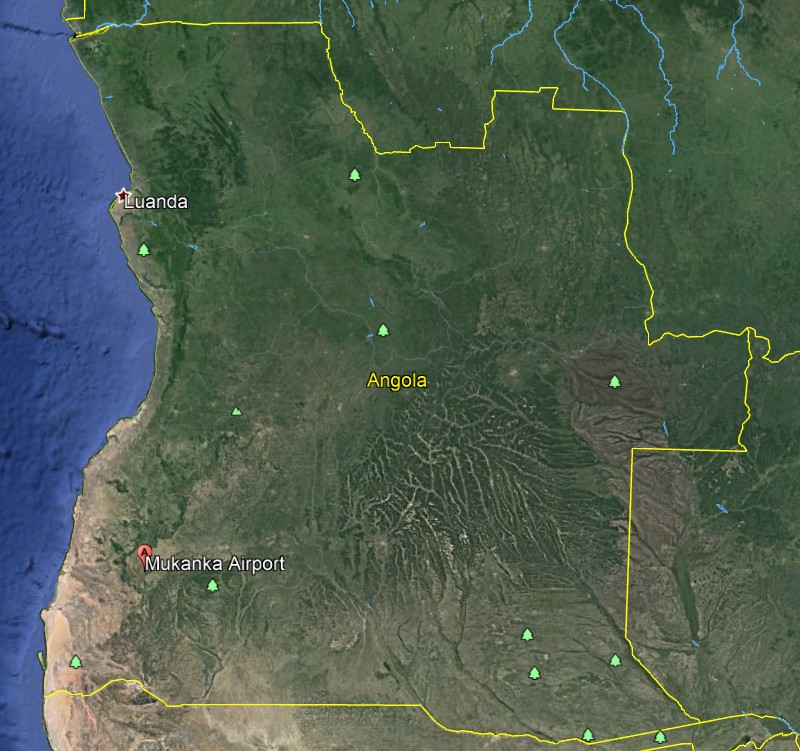

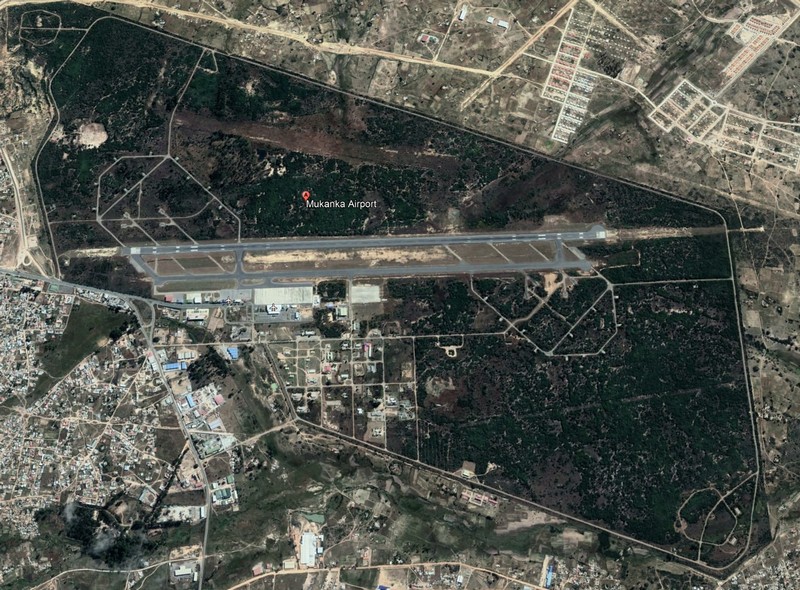
detail showing MiG-23 "parked" in pairs....
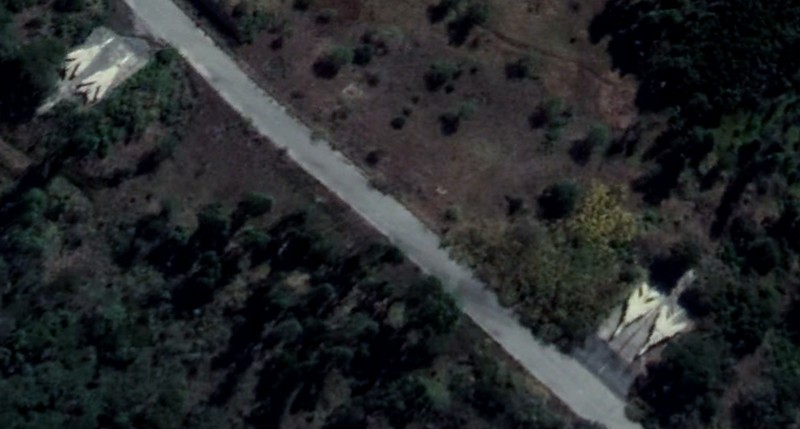
courtesy Google Earth imaging
Back to 1/72 Models.......
(c) Copyright Meindert "designer"/ All rights reserved/ Amsterdam The Netherlands. Your comments are welcomed by webmaster
Created this page
February 8, 2016

